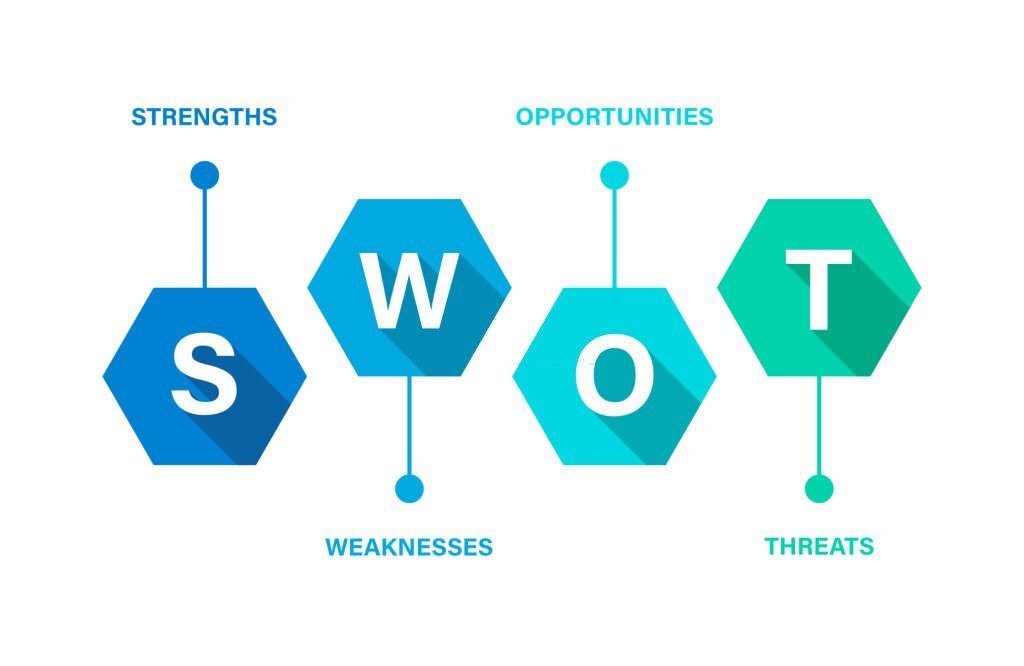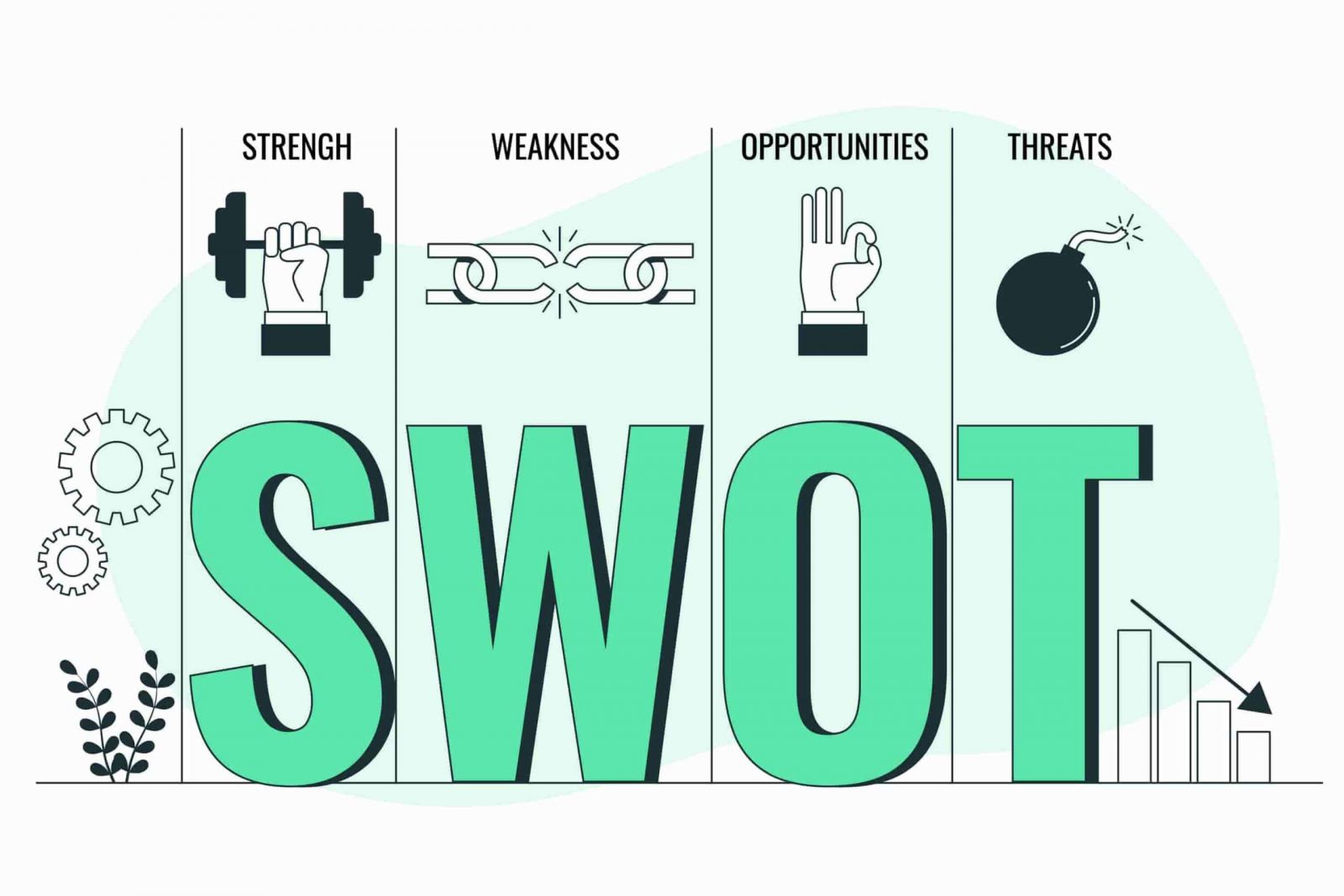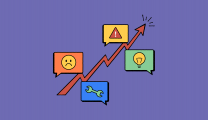What is SWOT Analysis?
As a planning discipline, SWOT is all about conducting a closer examination of your business, as well as all of the inside or outside factors that could affect the outcome of a project.
SWOT is an acronym that stands for:
Strengths
Weaknesses
Opportunities
Threats
During a SWOT analysis, you begin by methodically going over what your business does better than anyone else out there, as well as determining where it falls short — your strengths versus your weaknesses.
For example, your company’s strengths might be a prime location, a strong team, a killer marketing approach, or exceptionally high-quality services and products.
Weaknesses could include high overhead or a current lack of funding.
Once you know where your company’s doing great versus where it needs some work, you progress toward examining outside opportunities to improve, as well as any obstacles that could hinder your progress.
For instance, you may look to current marketing, political, and economic trends for ideas on where to take your product lines next.
When Should You Use SWOT Analysis?
SWOT analyses are the way to go when you’re facing challenges of an internal nature.
For example, perhaps you’re struggling to meet projected performance goals and aren’t sure why that’s happening.
You and your team might be preparing for a significant pivot like a rebranding campaign or a massively important product launch.
Or maybe your business is brand new, and you really need a read on where to steer things next.
All of those qualify as situations that call for a SWOT analysis. So use SWOT not only when you want to assess the current viability of your business but also when you need to identify any key outside influences that might be contributing to your internal issues.

It’s the best way to make sure the inner workings of your business are on-point before taking a risk or diving into anything else new.
What is PEST Analysis?
In contrast to SWOT, PEST is an analytical approach that examines external factors beyond your control.
The idea is to gain insight into how these factors could be affecting present or future sales, brand reputation, and so forth. PEST is an acronym that stands for:
Political
Economic
Social
Technological
Some people and companies use a variation of the PEST analysis called PESTLE, with the additional L and E standing for “legal” and “environmental,” respectively.
Whichever version of the acronym you choose to adopt, the end goal is the same — to identify and assess how relevant external forces could be affecting your company, the better to figure out where you stand in the current climate.
Although every professional’s PEST analysis will play out a little differently, there are certain key external factors everyone would do well to look at.
For instance, the dominant political party of the time almost always has some effect on elements like taxes, trade, and the basics of business development.
The same goes for the stock market with all its ups and downs.
You’ll also want to consider whether anything significant has changed in the tech world that affects how you or your customers use technology, in general.
Things also change about your target demographics and existing audience over time, so it’s worth reevaluating whether their needs, desires, and pain points are the same as they were the last time you checked.
When Should You Use PEST Analysis?
A PEST analysis is in order any time you need a clearer picture of how your business actually takes up space in the real world.
It’s also ideal for anticipating how business decisions you’re considering might play out given the current social, political, or economic climate.
PEST won’t help you with the inner workings of your business in and of itself. It will help you foresee any possible advantages or drawbacks of launching a new project under a given set of conditions.
PEST can help uncover threats you might not have seen any other way.
It can also help you nail down the ideal timing of weighty decisions like product launches, rebranding efforts, and attempts to expand into new demographics.
In fact, PEST is especially helpful when expanding operations into new geographic regions or foreign countries, as well as unknown markets.
SWOT vs. PEST Analysis: Which Is Better?
No analysis method is perfect, and SWOT and PEST are no exceptions.
Each approach has its unique benefits and disadvantages, and each is best applied to specific situations. That said, neither approach is better than the other.
Which is the right fit for your company depends mainly on your current situation and what you’re looking to find out by conducting analysis in the first place.
Again, PEST is best when you need to develop a better understanding of your company’s place in the bigger, ever-changing world out there, especially if you’re planning a significant business decision.
What worked for your business five years ago (or even last year) might not be working nearly as well now for many reasons.
The forces that run the world have changed, and so have your customers’ needs. PEST can help you figure out what changes to make to stay in step with the times and identify the best time to move forward.
And SWOT is the method to turn to when you need to better understand your company’s inner workings, including within the larger context of the consumer world.
SWOT can also help you figure out how to transfer your company’s existing strengths to new markets and demographics.
Occasionally, something that was a tremendous strength in one region could be a weakness in another, and SWOT will clue you in, so you’re not caught unprepared.
How Can SWOT and PEST Analysis Work Together?
Of course, you only need to choose between SWOT and PEST analysis if you want to.
The two actually complement one another beautifully, and when used together, can reveal a highly detailed portrait of your company and its current position.
Here’s a look at some of the benefits of using both before making any big decision.

Thorough Evaluation
Growth opportunities can often take unusual forms that are easy to miss when strictly using SWOT or PEST separately.
For instance, a current social change might well present once-in-a-lifetime chances for your company to get ahead or build its brand.
However, you could miss it if you’re not performing PEST alongside SWOT. The same goes for obstacles you need to be prepared for.
Encourages Strategic Thinking
Combining SWOT and PEST to create comprehensive analyses of your business decisions and their potential impact is an enriching experience for your entire team.
They’ll learn to think strategically and keep their eyes on the future throughout every aspect of planning a big move or putting a new idea into action.
The more intuitive this type of thinking becomes, the sounder your future business decisions will be.
Flexibility
SWOT and PEST aren’t just essential considerations when planning big business decisions or trying to get to the bottom of pressing issues.
When used together, they can be applied to a wide variety of different projects and used to assess the chances of success.
So don’t be afraid to try it out on your smaller endeavors, in addition to your significant overhauls, branding moves, and monumental choices.
The more you understand about what’s working for your company and what isn’t, as well as how a decision could change all that, the better.












Replies to This Discussion